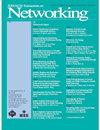结合容量和长度:寻找分层网络中的连接瓶颈
IF 3.6
3区 计算机科学
Q2 COMPUTER SCIENCE, HARDWARE & ARCHITECTURE
引用次数: 0
摘要
计算机网络通常是多层的。为简单起见,让我们重点讨论具有逻辑层和物理层的两层网络。这样的网络可以建模为一个标签图 $G = (V, E)$ ,标签集为 $L = \{\ell _{1}, \ell _{2}, {\dots }, \ell _{q}\关键问题是不同的边可能有相同的标签。在加权最小标签 s-t 剪切问题中,我们给定了一个带标签集 L 的标签图 $G=(V,E)$,其中每个标签 $\ell $ 都有一个非负权重 $w_\{ell}$,一个源 $s (在 V$ 中)和一个汇 $t (在 V$ 中)。这个问题要求找到一个权重最小的标签子集 $L'$(称为标签 s-t 切分),使得删除所有标签在 $L'$ 中的边可以断开 s 和 t 的连接。标签 s-t 切分描述了分层网络的连接瓶颈。它是对图的边连接性的自然概括。本文为加权标签 s-t 剪切问题提供了一种近似算法,其比率为 $O(n^{2/3})$ ,其中 n 是顶点数。这是第一个以 n 为比率的近似算法。该算法的关键点在于一种机制,可以将边上的标签权重解释为长度(如最短 s-t 路径问题)和容量(如最小 s-t 剪切问题)。随机图上的实验表明,该算法也具有良好的实用性能。本文章由计算机程序翻译,如有差异,请以英文原文为准。
Combining Capacity and Length: Finding Connectivity Bottleneck in a Layered Network
Computer networks are often multi-layered. For simplicity, let us focus on two-layered networks with logical layer and physical layer. Such a network can be modeled as a labeled graph
$G = (V, E)$
with a label set
$L = \{\ell _{1}, \ell _{2}, {\dots }, \ell _{q} \}$
, in which each edge (denotes logical connection)
$e \in E$
has a label (denotes physical link)
$\ell (e)$
from L. The key issue is that different edges may have the same label. In the weighted minimum Label s-t Cut problem, we are given a labeled graph
$G=(V,E)$
with label set L, where each label
$\ell $
has a nonnegative weight
$w_{\ell } $
, a source
$s \in V$
and a sink
$t \in V$
. The problem asks to find a minimum weight label subset
$L'$
(called a label s-t cut) such that the removal of all edges with labels in
$L'$
disconnects s and t. Label s-t cut depicts the connectivity bottleneck of a layered network. It is a natural generalization of the edge connectivity of a graph. In this paper, we provide an approximation algorithm for the weighted Label s-t Cut problem with ratio
$O(n^{2/3})$
, where n is the number of vertices. This is the first approximation algorithm for the problem whose ratio is given in terms of n. The key point of the algorithm is a mechanism to interpret label weight on an edge as both its length (as in the Shortest s-t Path problem) and capacity (as in the Min s-t Cut problem). Experiments on random graphs show that the algorithm has also good practical performance.
求助全文
通过发布文献求助,成功后即可免费获取论文全文。
去求助
来源期刊

IEEE/ACM Transactions on Networking
工程技术-电信学
CiteScore
8.20
自引率
5.40%
发文量
246
审稿时长
4-8 weeks
期刊介绍:
The IEEE/ACM Transactions on Networking’s high-level objective is to publish high-quality, original research results derived from theoretical or experimental exploration of the area of communication/computer networking, covering all sorts of information transport networks over all sorts of physical layer technologies, both wireline (all kinds of guided media: e.g., copper, optical) and wireless (e.g., radio-frequency, acoustic (e.g., underwater), infra-red), or hybrids of these. The journal welcomes applied contributions reporting on novel experiences and experiments with actual systems.
 求助内容:
求助内容: 应助结果提醒方式:
应助结果提醒方式:


